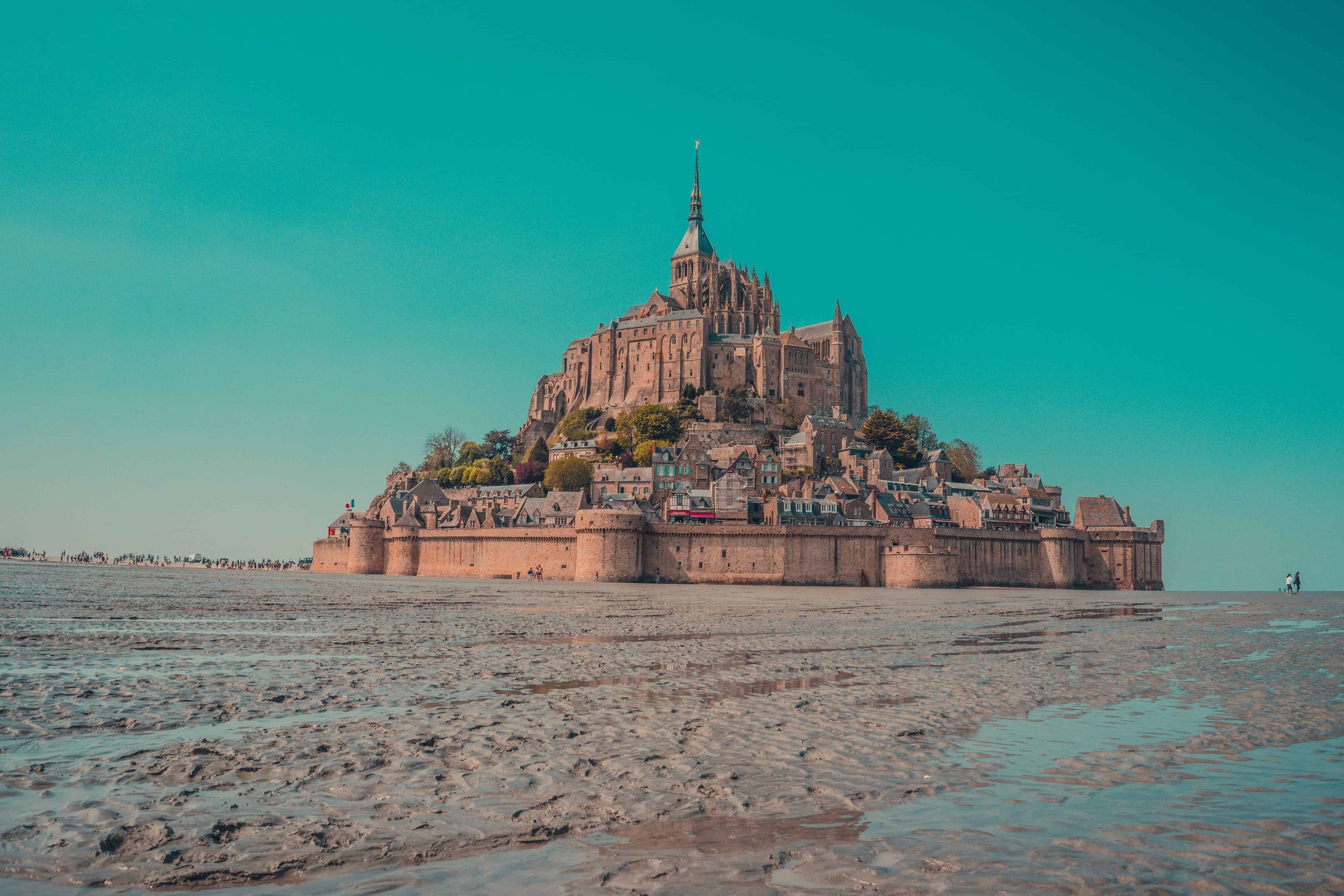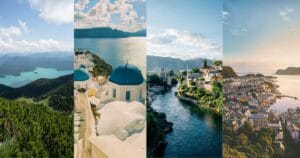France is an iconic country, and it was actually the most visited country in the entire world until very recently. It’s also one of the favorite destinations for Canadians and for a good reason: it’s beautiful. Many travelers dream of exploring this classic European destination, but as the French would tell you, Paris is not France, and France is not Paris.
France is often the cheapest European country to fly into from Canada, and Flytrippers often spots excellent prices on its cheap flight deals page these days, as low as the $400s roundtrip depending on the departure city!
Even though France is a bit on the expensive side for a budget traveler, there is another option: it’s a great place to enjoy on a stopover for a few days while heading to more affordable Eastern European countries, if you want to keep the total cost of your trip down. We’ll have a detailed post about this tip next week.
But if you don’t mind spending more, there’s a lot to see in the country itself. Below, I have compiled a list of great regions and cities to visit throughout metropolitan France that aren’t Paris and the French Riviera (where most visitors go).
From the big cities to the quiet countryside, this list has ideas for nearly every kind of traveler, although it’s obviously not an exhaustive one. Feel free to share your own favorite spots in France in the comments.
Here are the 5 best regions to visit in France—and 10 cities in those 5 regions.
1. Alsace
Strasbourg
Strasbourg is the heart of Alsace. It’s a historically rich region of France full of German and French influence—so historically rich that it’s often distinctly noted how some locals are referred to as Alsatian and not French. Although, if you’ve been to Paris, you won’t feel too far from home in this Alsatian culture.
Strasbourg is notoriously known as la Capitale de Noël with its festive Christmas markets. Festivities typically begin as early as the end of November and finish towards the end of December after Christmas.
If you happen to go (which I suggest you do, I certainly plan on going someday), it’s imperative to visit Place Kléber to see the giant Christmas tree decked to the halls with shimmering lights and to stroll through the markets for warm mulled wine, aligot, and the sweetest beignets.
Also, make sure to take a night stroll along the Quai des Bateliers, have a tour of Cathédrale Notre-Dame de Strasbourg, (whose second tower has never been completed), and then explore La Petite France for its timbered homes and medieval wooden-covered bridges.
Colmar
If you’re already in Strasbourg, take the 15-minute train ride to Colmar for as low as C$20. This adorable little town is full of cute Alsatian shops with authentic crafts and sweet treats, fantastic sit-down restaurants like le Fer Rouge, and their famous Petite Venise, or Little Venice.
If you’re into sculpture and France–United States relations, then you’ll be intrigued to learn that Colmar is the birth city of Auguste Bartholdi, the sculptor behind the Statue of Liberty and many other famous sculptures in France.
In the historical center of town, you’ll find the Bartholdi Museum. This museum houses models and sketches of many of his famous works, including the Statue of Liberty. There is also so much information concerning his life, how he become the sculptor/architect that he was, and even one unusual occurrence where he was left uncredited for his contribution to a concept.
So, if you’re into mysteries and sculptures, that museum is the place for you. And, luckily, it’s not that expensive to go—only €6.50!
2. Occitanie
Montpellier
Ahhh, Montpellier—grace, elegance, and natural beauty.
From high mountain peaks, cobblestone streets, to white sandy beaches, Montpellier is packed with opportunities for adventure.
Begin in the historical center at la Place de la Comédie, where you’ll meet the Three Graces standing proudly in front of the Opera. Continue westward along wide promenades while soaking in the Haussmannien-style buildings.
Eventually, you’ll find yourself in front l’Arc de Triomphe and Promenade du Peyrou, constructed in the 17th and 18the centuries. At the far end of the promenade lies the Saint-Clément Aqueduct, which once served as a water source for the city in the early 18th century.
To the northwest, you have Pic Saint-Loup mountain, which offers a picturesque 4-hour hike to the summit and its steep cliffside. The region is also locally renowned for its wineries.
To the east lie a line of Mediterranean beaches from la Grande Motte to as far as Sète. Montpellier’s efficient tramway system can drop you off at the end of line 3 in Pérols/Etang-de-l’Or, a 20-minute walk from the beach.
Sète
A short 15-minute train ride from Montpellier lies this tiny city on the Mediterranean Sea. Many of the French in the south revere Sète as the la Venise du Languedoc, which translates to the Venice of Languedoc. Once you walk through the streets and alongside its canals, you’ll understand its nickname right away.
Sète is also renowned for its cuisine, sourced freshly from the Mediterranean Sea. One of its most unique dishes is the tielle: a pie with red sauce and seafood, be it shrimp, lobster, or squid.
Lastly, make sure to save time for a hike up Mont Saint Clair. In about 30 minutes up a steep incline, you’ll reach the panoramic view at the top—definitely worthwhile, especially on a bright sunny day. From the top, you’ll be able to see Montpellier and even Pic Saint-Loup.
Carcassonne
A bit further southwest of Montpellier towards the Pyrenees sits the city of Carcassonne. One of the greatest sites to visit here is la Cité de Carcassonne, which is one of the most intact walled cities in France dating back to the Middle Ages.
A constant battleground, la Cité acted as a stronghold for France in protecting the Occitanie region from surrounding nations. Most notably, under the reign of Charlemagne, it was recaptured in the 8th century.
Now in the 21st century, Carcassonne is a larger city surrounding the old Cité on the hill. Despite its smaller size, la Cité has much to see. Enjoy a walk up to the large gated entrance and then atop narrow cobblestone paths with dainty, crooked shops tucked away.
The ramparts, however, draw the most attention with a tour of the old fortress and castle within la Cité. Most of it has been restored to preserve its authenticity.
3. Britanny
Finistère
If you’re the outdoorsy type, you will love this region. Most of the coastal areas in Brittany, especially near Finistère (translated as “the end of the world”) is flat, rocky, and lined with cliffs, which makes it easy to stroll along or climb if you’d like.
One of the best spots here is la Pointe du Raz. It’s the westernmost point of the Sivan peninsula jutting out in the Iroise Sea that hugs the Atlantic Ocean. The view is breathtaking, the walk is simple, and there is a nice lighthouse. Make sure to take your windbreaker because the winds howl forcefully here!
St. Malo
As a medieval port city, St. Malo was perfectly situated for many sailors from England and the Netherlands to stop in for supplies before the long journey across the Atlantic to the New World. It’s also told that this city was popular among Pirates, even ones as infamous as Blackbeard himself.
Nowadays, the city’s fortified structure remains intact even after World War II, and the city has since grown beyond these walls.
You must stop at one of the many crêperies for an authentic sweet crêpe or a savory galette. Find yourself a pint of cider too; Northern France produces the best of it apparently.
Famous Romantic poet and writer, François-René de Chateaubriand, was born here and was put to rest on the island Grand-Bé, just outside the city’s walls. If you’ve read his work, you can stop here to learn and experience more about his childhood.
4. Normandy
Mont Saint-Michel
If you’ve dreamed of going to France and have looked at photos of France, then Mont Saint-Michel is probably already on your list!
Since the 10th century, the island and the monastery, which gave the island its name, has become what it is today. Over 10 centuries, the island mountain has become fortified, the abbey has grown larger, and many people have come and gone; to visit as well as to live.
Today, only about 50 people live on the island. But in 1851, 1,182 people lived in this tiny commune.
If unlike me you’re a Harry Potter fan, the narrow, cloggy streets leading up to the entrance of the monastery will remind you of Diagon Alley.
If you’re lucky, you could witness a rare “super tide,” which surrounds the monastery and turns it into an actual island. In 2015, the bridge, along which visitors walk to get to the abbey, was entirely flooded by this tide. Some say we should visit this monument before we find out how the rising sea levels will affect it.
Juno Beach and Omaha Beach
Another great area to visit in Normandy is Juno Beach and Omaha Beach, where many brave soldiers stormed France on June 6, 1944, during World War II.
There are a few reasons to visit this area. For starters, in the nearby city of Caen, there is the Memorial Museum dedicated to the history of World War II.
Secondly, closer to the beaches, you have the Juno Beach Centre, the American and German cemeteries, the beach itself, as well as Hoc Point, which is known for its enormous craters and anti-aircraft bunkers left in ruins.
5. Alps
Chamonix
The beautiful French Alps region is not just for skiers. I spent 10 days at the foot of the Mont Blanc in the summer of 2018, and I’ll share a separate article about that trip at some point. Even without winter sports, the mountain setting is just as impressive and the village is still beautiful.
I took the cable car to the Aiguille du Midi to soak in the view going up, but also to walk out onto the glass platform over the Alps a mere 3,842 meters above the ground. I also walked inside an actual glacier and went on a daytrip to beautiful Annecy too.
Bonus: Corsica
Since we love giving you more bang for your buck here at Flytrippers, here’s a bonus destination that isn’t too common with Canadian travelers.
Not many people think about Corsica when they think about going to France. Often, the first thought is the French Riviera in the south for those who enjoy nice beaches.
However, Corsica is a beautiful island that we featured in our article about the best islands to visit in the Mediterranean Sea, perfect for a quiet vacation in a mixed Italian–French culture but with a lot of things to see and a bit fewer tourists.
Two cities to visit are Bastia, in the north, and Bonifacio, in the south. It’s easy to split the island in two by north and south because the geographical differences are stark.
Bastia
Beginning in the north, Bastia is one of the smaller, yet livelier cities with an old charm that leaves you wanting to stay.
It’s home to the second busiest passenger port, after Calais in mainland France. So, maybe you can pop over to Italy on a $45 ferry!
But, if you’re planning to stay in Bastia for a while, you should stroll through the Terra Nova: a citadel built between the 15th and 17th centuries for the city’s old Genoese masters.
In comparison to the rest of the city, the citadel is primarily residential and quiet but offers the Museum of Bastia and the majestic Cathédrale St. Marie, which holds a mysterious black-oak crucifix found in the sea around 1428.
If you love food, you should then go to A Scudella for dinner for an authentic Corsican meal. Try one of their beignets de brocciu—a sweet, lemon-scented fritter filled with ricotta Brocciu cheese.
Bonifacio
Near the southern tip of the island lies the city of Bonifacio, placed perfectly atop a rocky peninsula surrounded nearly entirely by limestone cliffs.
Bonifacio is uniquely known for its ancient fortress, tangled with alleyways, and chipped pastel-painted edifices. Continuing, you could find Aragon’s Stairs, a steep, narrow stairway carved into the cliffside leading to a smooth, stone path alongside countless sea-foamy waves.
It’s a can’t-be-missed destination.
Flytrippers will be posting more articles about amazing destinations! Subscribe to our free newsletter below so you don’t miss out.
Want to get more content to discover awesome destinations?
Summary
As you can see, France has a plethora of cities, sights, and delicious food for everyone! These 5 regions are an excellent start for your next visit to France, if you want to avoid common destinations like Paris and the French Riviera.
What would you like to know about the best regions in France? Tell us in the comments below.
See the deals we spot: Cheap flights
Explore awesome destinations: Travel inspiration
Learn pro tricks: Travel tips
Discover free travel: Travel rewards
Featured image: Mont Saint-Michel (photo credit: Bharat Patil)
Original publication date: October 29, 2019
Advertiser Disclosure: In the interest of transparency, Flytrippers may receive a commission on links featured in this post, at no cost to you. Thank you for using our links to support us for free, we appreciate it! You allow us to keep finding the best travel deals for free and to keep offering interesting content for free. Since we care deeply about our mission to help travelers and our reputation and credibility prevail over everything, we will NEVER recommend a product or service that we do not believe in or that we do not use ourselves, and we will never give any third-party any control whatsoever on our content. For more information on our advertiser disclosure, click here.




